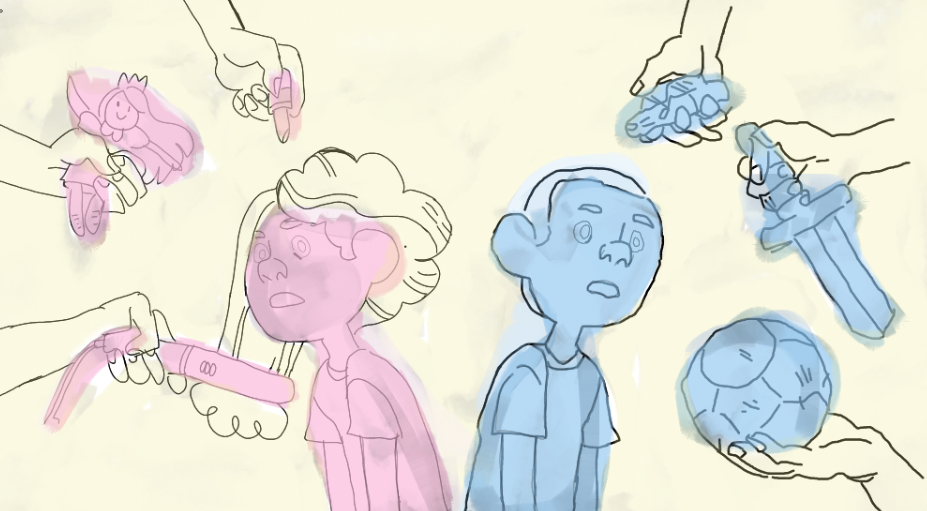
Toy store aisles aren’t even blue and pink anymore. Why are some Harrison clubs primarily made up of exclusively boys or exclusively girls?
As children, we’re immediately taught the difference between a man and a woman; often this means that men should be tough, independent, and dominant, and women should be soft, kind, and nurturing. This separation by “definition” forces young boys and girls into boxes that most never grow out of, and it creates a social divide in how we interact with one another, our careers, and even our confidence in ourselves.
Adults as Agents of Gender Socialization
The conditioning begins when we’re kids, with toy advertisements, believe it or not. I’m sure we’ve all experienced the simple color difference of walking into the toy section of any given store, seeing the stark contrast between the pinks and purples of the girls’ section, and the blues and reds of the boy’s section. Olivia Guy-Evans at “Simply Psychology” says “[these] types of toys…are thought to reinforce what gender should do.” Boys are geared toward trucks, building blocks, and toy weapons. This reinforces the idea that men are the strong “provider” type; while girls are steered toward dolls and kitchen sets, which promotes the idea of women in care-taker roles. These gender stereotypes have been historically accepted as “normal” in most cultures, and in most instances we’re aware of the divide.
The toys we play with as little kids aren’t the only factors of gender socialization. The adults in our lives are also agents of gender socialization, though they may not realize it. Think about a time you’ve gone to a hospital or seen a primary care physician. The nurses are primarily women, right? And when we compliment small children, what words do we use? For boys, they’re typically described as strong, whereas girls are pretty. Without even realizing it, we’re setting the standard that certain genders have certain implications.
Boys in Clubs “for” Girls
I spoke to a group of kids in HOSA, which is a class offered here at Harrison for students interested in careers in the medical field. Ms. Jennifer Abel concludes that of the students that take her class, she has about 20 male students, compared to 110 female students. When asked about the low demographic of boys in the class, HOSA President Ridge Owens responded “at our age, women are more willing to put in effort”. This is most likely in reference to the focus and duration of the HOSA program, as well as careers within the medical field, which is furthered by student John Tang’s claim that the career takes longer, therefore guys feel less inclined to take it.
Both of these students also brought up the interesting idea that healthcare related careers aren’t socially accepted as “blue collar” career paths. Owens claims that there is a stigma surrounding both the class and career path, which deters young men from pursuing the program.
Neither male claims that the lack of other guys is detrimental to their learning environment, but both agree that more guys could be beneficial in breaking the stigma. A female student in the program that I spoke to, Carly Shircliff, when asked about the male participation in the HOSA program, determined that more guys in the class would be beneficial in establishing multiple viewpoints on medical and health related issues.
Girls in Clubs “for” Boys
On the opposite side of the gender divide from HOSA is our Robotics program. Junior Vivian Smith, one of the few girls in robotics, said something similar, stating “…you want multiple perspectives…[for] problem solving…”. She communicates that robotics is now a co-curricular club with Project Lead the Way, Harrison’s engineering program. Smith believes that this is because young girls aren’t exposed to many women in engineering careers. She states, “…you don’t see many dads taking their girls out and teaching them how to build stuff and fix the cars”.
Smith also says that the fact that robotics is co-curricular with engineering has deterred many members of the Robotics Club from joining this year. She said many students dropped the class because they aren’t interested in engineering careers, meaning that they can’t be robotics anymore.
We look to the adults in our lives as role models for what we should and shouldn’t do or be. We do what they do, say what they say and how they present gender is how we frame our own for the rest of our lives. We build our personalities and careers off of the world’s interpretation of our gender, and it separates from each other and from our true potential.